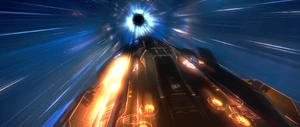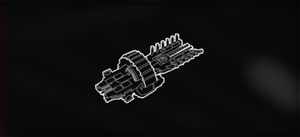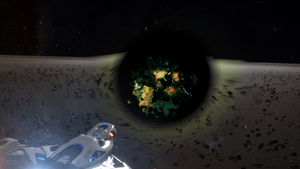
An Anaconda making a hyperspace jump
A hyperdrive is a device which allows ships to achieve faster-than-light speeds and travel through hyperspace. In the 34th century, the Frame Shift Drive is the predominant model of hyperdrive among human civilisation, and is installed in practically all vessels in operation.
Human hyperdrives[]
Early hyperdrives[]
A team of engineers led by Li Qin Jao invented the first hyperdrive in the 22nd century. Early hyperdrive models based on the Li Qin Jao design were slow and inefficient, but exponentially faster than sublight travel, which thousands of Generation Ships were forced to rely on.[1] Until the 2800s, hyperdrive technology was mainly only available to corporations and governments, similar to how affordable starships were also beyond the reach of consumers until the introduction of the Python in 2700.[2]
Faraway Jump and quirium drives[]
The first commercially-available hyperdrive was the Faraway Jump, introduced in the 2800s. This model had a relatively short jump range, but travelers spent only a brief time in hyperspace with each jump. It was powered by a fuel called quirium, an energy-dense material exclusively produced by the Galactic Cooperative. The Faraway Jump was known for its delicacy, however, and depended on a complex network of monitoring satellites, branch lines, stop points, and rescue stations, all of which took centuries to establish, in order to operate smoothly. After GalCop dissolved in 3174, the secret formula necessary to manufacture quirium fuel was lost, and the hyperspace industry suffered a major setback. With all quirium drives no longer usable, faster-than-light travel reverted to slower and more primitive methods.[2]
Dredger drives[]
Dredgers utilised a type of hyperdrive that was a contemporary of the quirium drive, but did not consume specialised quirium fuel. Dredger J-403 was built in 3088, but remained fully operational over two centuries later in 3307, and synthesised the fuel and other resources it needed by taking in and converting raw and salvaged materials from planetary rings and derelict ships. Dredger hyperdrives possessed a jump range similar to the 500 light-years that 34th century fleet carriers could achieve. Although dredgers could be maintained for centuries, their design was rendered obsolete by later hyperdrive models that could be more easily refueled and repaired.[3][4][5]
Type 2b[]
Between 3174 and 3297,[6] a number of different hyperdrives strove to fill the void left by the loss of quirium drives. The Type 2b proved to be the most popular,[2] but it had two significant downsides compared to its predecessors. First, ships spent a significantly longer time, often hours or days, in hyperspace during each jump.[6][7] Second, ships equipped with a Type 2b drive left behind a hyperspace "cloud" at both their entry and exit points, making it a simple task for malcontents to track and ambush them.[2]
Frame Shift Drive[]
- Main article: Frame Shift Drive

A Frame Shift Drive
The latest significant hyperdrive model is the Frame Shift Drive, which had a long and secretive development period before its introduction to the public in 3297.[6][2] Previous hyperdrive models were mostly decommissioned and regulations were introduced to mandate upgrading to the new technology. The use of tantalum in Frame Shift Drives caused the metal's price to skyrocket, and interstellar powers moved quickly to control tantalum sources, as seen with Imperial Senator Algreb Loren's conquest of the Prism system to seize the tantalum-rich moon Chione.[8]
Initially believed to be an innovation created by Sirius Corporation, the Frame Shift Drive was in fact reverse-engineered by the Alliance from Thargoid ships that had been captured by the Galactic Cooperative during the First Thargoid War between 3125 and 3151.[7] Sometime during the war, at the INRA base Almeida Landing, a research team led by the engineer Effie Ratling figured out that Thargoid hyperdrives operated by creating stable wormholes into and out of hyperspace, a key difference from contemporary human-designed hyperdrives which shifted space around a ship. Ratling built a prototype hybrid hyperdrive, considered a precursor of the modern Frame Shift Drive, using elements of both human and Thargoid tech, but INRA then took over the project and made modifications to the hybrid drive to get it to the test-flight stage, allowing Ratling to stay on only as a consultant. During the first test flight, the wormhole produced by the prototype drive was stable, but Ratling voiced concern about whether a human being would survive passing through it. Her worries proved prescient, as the pilot died when he returned from the wormhole; his body was turned inside out, but the ship was unscathed. It is unknown what became of INRA's prototype after this.[9]
After the collapse of the Galactic Cooperative in 3174, dozens of Thargoid vessels that GalCop forces had captured and stored eventually fell into the hands of the Alliance after it was established in 3230.[7] By the 3270s, the Alliance was able to reverse-engineer Thargoid technology and produced the revolutionary Frame Shift Drive, which it quietly ceded to Sirius Corporation at the behest of The Club in the hopes of preserving the balance of power between the three superpowers. Sirius monopolized the technology and distributed it to all the powers and factions, ensuring no one gained an advantage.[7] News of the Frame Shift Drive's development precipitated the signing of the London Treaty in 3278, in which the superpowers agreed to limit the construction of Capital Ships for the sake of preventing an arms race.[10] The completed Frame Shift Drive was unveiled in the late 3290s,[2][7] and immediately rendered the Type 2b obsolete when it became widely available in 3297.[2][6]
The new design had numerous advantages. Jump times were reduced to mere seconds, as they had been with quirium drives, without any loss in jump range compared to the Type 2b. Journeys that were considered unfeasible were now within the realm of possibility.[2] In addition, the new design was more compact and could be installed on smaller ships, it was more fuel efficient, and it locked onto a system's primary star, dropping a ship there instead of a system's outskirts and reducing travel times to most populated worlds and bases. Last but not least, the Frame Shift Drive also introduced a supercruise mode that further cut in-system travel times from days to minutes.[6]

A Fleet Carrier emerging from hyperspace
Frame Shift Drives consume one of two different kinds of fuel depending on their size. Drives installed in smaller, conventional ships from the Sidewinder MkI to the Anaconda use simple Hydrogen Fuel, which is readily available at any docking facility or by using a Fuel Scoop to skim it from certain classes of stars. Megaships and Capital Ships, including the Farragut-Class Battle Cruiser, Majestic-Class Interdictor, Drake-Class Carrier, and Wells-class Carrier, use much more powerful Frame Shift Drives that consume Tritium, which must be purchased by the tonne from commodity markets or mined from asteroids and refined.[11]
Frame Shift Drives leave behind temporary Frame Shift Drive Wakes, which can be scanned using a Frame Shift Wake Scanner to calculate a ship's destination system. Fortunately, these wakes fade in a matter of minutes, making it considerably more difficult to pursue a ship over multiple jumps. The company MetaDrive Inc. reportedly came close to developing wake suppression technology for the commercial market, an innovation which would have allowed any ship to travel through a system without leaving a trace, but MetaDrive was acquired by Sirius Corporation in late 3302 through The Club's manipulation and the research was likely shelved indefinitely to prevent the disruption of the balance between the superpowers.
Star Ports[]
A small number of Star Ports are also capable of entering Hyperspace, particularly the Ocellus class. These stations tend to have their principle mega-structures and port facilities assembled along with a massive frameshift drive. The station then typically travels to its assigned system, before construction is completed on-site.
A unique example of a Star Port that can enter Hyperspace is Jaques Station, an older Orbis class that was outfitted with a Frameshift drive by its owner, the cyborg Jaques. Famously, this port encountered a misjump while traveling to Beagle Point in 3302, as a result of Thargoid Sensor interference. Its drop point, nearly 22,000 ly from Sol, became the focal point of a new era of deep space colonization, eventually becoming the Colonia region.
While it is not made clear if it is the case for all Hyperspace capable Star Ports, Jacques station's Frame Shift Drive is powered by Hydrogen fuel instead of Tritium. Millions of tonnes needed to be gathered during a community goal in order to fuel its attempted jump to Beagle Point.
Alien hyperdrives[]
Thargoid hyperdrive[]

A wormhole into hyperspace formed by a Thargoid hyperdrive
The hyperdrive used by the Thargoids differs dramatically from human models in both form and function due to the Thargoids' unique technology base. Thargoid hyperdrives are biomechanical in design and grown to purpose from exotic metals, such as Meta-Alloys, and organic polymers. The latter material shares some commonalities with the composition of Thargoid exoskeletons, and was found to be a key weakness of the Thargoids during the first Thargoid War, when INRA developed and deployed the mycoid weapon. Mycoid proved to be extremely harmful to these polymers, damaging Thargoid hyperdrives beyond repair and even killing entire Thargoid Motherships, and is thought to have been the decisive factor in humanity's apparent victory.[7] As of the 34th century, however, the Thargoids have mitigated their vulnerability to mycoid.[12]
Thargoid hyperdrives are substantially more accurate than human hyperdrives. Whereas Frame Shift Drives are only capable of jumping a ship from one star system to another and generate a transient corridor through hyperspace to do so, Thargoid hyperdrives allow their ships to hover in hyperspace indefinitely as well as drop out of hyperspace at specific points within a star system, completely negating the need for a supercruise-like mode.[13] Thargoid jump wakes are also currently opaque to human Frame Shift Wake Scanners and produce only Thargoid Wake Data when analysed, rendering pursuit impossible.
Thargoid hyperdrive technology may have limits however, although what these limits are have yet to be determined. Following the battle of HIP 22460, a number of Rogue signal sources of Thargoid origin began converging on the core systems. These objects (far larger than any known human Star Port) did not move through hyperspace, but seemingly through real space at faster-than-light speeds (the radiation output from these structures appeared to be superluminal, as their wakes could be seen and picked up by scanners for several light years in all directions). The estimated speed for these objects was in excess of 8,000c (more than 4 times faster than a human ship at maximum Supercruise). The first of these objects (dubbed Taranis) decelerated to orbit around an Ammonia World in the Hyades Sector FB-N B7-6 system on the 29th of November 3308, after more than 3 months traveling from the far side of the Orion Complex.
It is unclear if Thargoid Interceptors or scouts can also move at FTL speeds, though since the arrival of Taranis, invasion forces are now capable of interdicting human ships from supercruise. Whether this is a latent capability, or a new development on the Thargoid's part to better engage humanity in combat, remains to be seen.
Guardian hyperdrive[]
Guardian hyperdrive technology was also considerably different from human technology and remains poorly understood. It is known from recovered records that the Guardians achieved normal space travel speeds roughly on par with modern humans using clean nuclear fission and fusion, but their hyperdrives had vastly superior jump ranges.[14] In 3304, the Engineer Ram Tah succeeded in producing a module based on Guardian designs known as the Guardian Frame Shift Drive Booster, which patches into a Frame Shift Drive and augments its fuel efficiency to increase a ship's jump range by up to 10.5 light-years.
References[]
- ↑ GalNet: The Founding of the Federation
- ↑ 2.0 2.1 2.2 2.3 2.4 2.5 2.6 2.7 GalNet: Hyperspace
- ↑ GalNet: Galactic Mysteries: Dredger Clans
- ↑ GalNet: Scriveners Clan Abandons the Hesperus
- ↑ GalNet: Dredger Clan Faces Possible Extinction
- ↑ 6.0 6.1 6.2 6.3 6.4 Elite Encounters RPG
- ↑ 7.0 7.1 7.2 7.3 7.4 7.5 Elite Dangerous: Premonition
- ↑ Elite: Reclamation
- ↑ reddit: Elite: Dangerous: Another INRA Base Found, Linked To Hyperdrive Research
- ↑ GalNet: Economic Turmoil Ahead?
- ↑ YouTube: Fleet Carriers - Content Reveal (18:00 UTC)
- ↑ Elite Dangerous Knowledge Base > The Thargoids > Vulnerabilities
- ↑ GalNet: Genesis of the Thargoids?
- ↑ Canonn Research: Guardians Codex 13/28 : Technology Log - Starships, 19/28 : Technology Log - Hyperdrives
